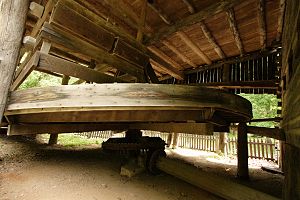- Treadwheel
-
- The word treadmill, originally a type of mill operated by a person treading steps of a wheel to grind grain, now designates a piece of indoor sporting equipment for running without moving any distance.
A treadwheel is a form of animal engine typically powered by humans. It may resemble a water wheel in appearance, and can be worked either by a human treading paddles set into its circumference (treadmill), or by a human or animal standing inside it (treadwheel).
Uses of treadwheels included raising water, to power cranes, or grind grain. They were used extensively in the Greek and Roman world, such as in the reverse overshot water-wheel used for dewatering purposes.
They were used in prisons as penal labor in the early Victorian period in Britain as a form of punishment. Illustration of prisoners on 1821 treadmill used to mill corn in Surrey House of Correction (now Brixton Prison)[1]. According to The Times in 1827, and reprinted in William Hone's Table-Book in 1838, the amount prisoners walked per day on average varied, from 6,600 feet at Lewes to 17,000 feet in ten hours during the summertime at Warwick gaol.[2]
A treadwheel was also used in a submarine in 1851 to pump air to change buoyancy and thus make the vessel dive or rise.[citation needed]
See also
- Horse mill
- List of historical harbour cranes
- Treadwheel crane
References
- ^ Weinreb and Hibbert (1995). The London Encyclopedia. Macmillan Reference Books. pp. 95. ISBN 0 333 57688 8.
- ^ "Tread Mills", in The Every-day Book and Table Book; or, Everlasting Calendar of Popular Amusements, Sports, Pastimes, Ceremonies, Manners, Customs, and Events, Each of the Three Hundred and Sixty-Five Days, in Past and Present Times; Forming a Complete History of the Year, Months, and Seasons, and a Perpetual Key to the Almanac, Including Accounts of the Weather, Rules for Health and Conduct, Remarkable and Important Anecdotes, Facts, and Notices, in Chronology, Antiquities, Topography, Biography, Natural History, Art, Science, and General Literature; Derived from the Most Authentic Sources, and Valuable Original Communication, with Poetical Elucidations, for Daily Use and Diversion. Vol III., ed. William Hone, (London: 1838) p 755.
Further reading
- Animal-powered Machines, J. Kenneth Major. Shire Album 128. Shire Publications, 1985. ISBN 0-85263-710-1
Categories:- Grinding mills
Wikimedia Foundation. 2010.

